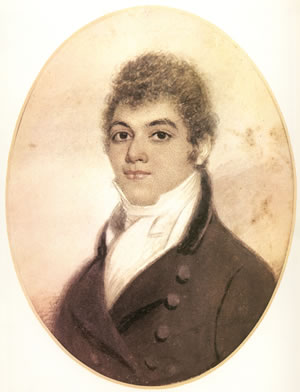By Daniel Hathaway
. Gallery music returns to CMA
. Ticket sales are steadily recovering post-Pandemic, says the New York Times, in an article featuring The Cleveland Orchestra and its inaugural Arts & Humanities Festival
. Almanac: Premiere of Beethoven’s “Kreutzer” Sonata by George Bridgetower (pictured), births of Harold Budd, Michael Horwood & Phil Fried, departure of Jacob Druckman
HAPPENING TODAY:
There’s music in the galleries at the Cleveland Museum of Art again today at 6pm. “Modern, American, and Accessible” will find Eva Mondragon, violin & viola, Jenny Cluggish, violin, Paul Kirk, fiddle, Stephan Haluska, harp, Ellie Glorioso, cello, and Chris Jenkins, viola performing works by modern American composers in the Contemporary Art Gallery. Composers range from Pulitzer Prize–winner Caroline Shaw to African American composer Coleridge-Taylor Perkinson, and the playlist will include concert music by comedic classical composer Peter Schickele, and fiddle music arranged by Paul Kirk. It’s free.
INTERESTING READ:
The Cleveland Orchestra and its inaugural Arts and Humanities Festival are featured in today’s print edition of The New York Times as part of a general survey of organizations that are now seeing an increase in subscriptions and ticket sales following a drop off during the pandemic and a weak recovery at the beginning of the concert season.
“There were film screenings, theater productions, panels, readings, an art tour — many of the offerings collaborations with other Cleveland institutions. Over 24 hours, it was possible to pair a “Fanciulla” matinee — the playing sumptuous yet lucid under the orchestra’s music director, Franz Welser-Möst — with a rousing performance by local choruses and a keynote speech from the writer Isabel Wilkerson (“The Warmth of Other Suns,” “Caste”).
“These events weren’t full, but the audiences responded warmly — standing and dancing at their seats for the charming choruses — and the festival was a compelling proof of concept, an ambitious achievement to put an exclamation point on a roller-coaster season.” Read the article here.
ALMANAC FOR MAY 24:
by Mike Telin
Early in the morning of May 24 in 1803, Beethoven’s Violin Sonata No. 9 (“Kreutzer”) was premiered in Vienna by violinist George Bridgetower, with Beethoven at the piano. You can read more about the work’s interesting history — and less than stellar first performance — here.
Our birthday list is highlighted by three Americans. In 1936 composer and poet Harold Budd came into the world in Los Angeles. Although Budd was first known for his minimalist and avant-garde pieces he was better known later for his work with Brian Eno and Robin Guthrie.
In 1947, composer Michael Horwood was born in Buffalo, New York. on May 24, 1947. A student of composition and theory at the State University of New York at Buffalo, his teachers included Lejaren Hiller, Lukas Foss, and Istvan Anhalt. He served as professor of music and humanities at the Humber Institute of Technology and Advanced Learning in Toronto, Ontario. He also formed the improvisation ensemble Convergence, in which he played piano and percussion.
And in 1955, composer Phil Fried was born in New York City. His catalog of works include free improvisation, orchestral music, vocal music, solo, and chamber music. On his website he writes: “For me there are two kinds of improvisation: 1) collaboration with others which is a shared experience of reacting to others to make the form, and 2) solo improvisation which is composing in the moment.”
There is one passing to mention: in 1996 composer Jacob Druckman left the world in New Haven at the age of 67. Known for his extensive work in electronic music, he also wrote for small ensembles and orchestras. In 1972 he won the Pulitzer Prize for Windows, and served as composer-in-residence of the New York Philharmonic from 1982 until 1985. Druckman taught at Juilliard, The Aspen Music Festival, Tanglewood, Brooklyn College, Bard College, and Yale University. Click here to watch an interview with Druckman during which he talks about his compositional process — “the first measure of a piece is just too terrifying beyond words,” he says.
Click here to listen to Aureole: for orchestra (1979) performed by the New York Philharmonic under the direction of Gunther Schuller.




